A FEW MONTHS AGO 13-year-old Andrew Tyler used his parents’ credit card number to bid millions of dollars on eBay, after offering his best friend for sale as a slave (bidding was to begin at $1). Andrew would probably get along famously with Eloise—whom the New York Times long ago dubbed “the hotel brat”—if she weren’t a figment of author Kay Thompson’s imagination.
The irrepressible Eloise lives in a suite at the Plaza Hotel, where she “skibbles” through the halls, crayon at the ready. Depending on your temperament, you want to throttle her or adopt her—sometimes both at once. She’s a 6-year-old whirlwind of energy and caprice, and she’s back in full force this Christmas.
Created by actress, musician, and bon vivant Thompson (and depicted with divine whimsy by illustrator Hilary Knight), Eloise was the crowning achievement in a life full of accomplishment. Thompson is credited with bringing jazz to the Hollywood musical and helping Judy Garland and Lena Horne discover their own unique vocal styles. She starred in a groundbreaking cabaret act, backed by the Williams Brothers. “Think pink!” was her mantra when she played a Diana Vreeland-ish fashion editor in Stanley Donen’s Funny Face.
But her book—Thompson always zealously referred to it as Kay Thompson’s Eloise—trumped them all. Eloise was unleashed in 1955, long before the phrase “inner child” existed. Still, the vivacious girl with the unkempt hair and convex tummy enthralled millions of grown-ups along with their kids. In a 1969 interview with the National Observer, Thompson actually admitted that she’d written Eloise for adults. “There were all sorts of people who thought Eloise was about them,” she noted, “even a man who wrote to me that he was born in the Plaza’s 58th Street elevator.”
Thompson and Knight collaborated on three sequels: Eloise in Paris, Eloise at Christmastime, and Eloise in Moscow. At one point during the ’50s you could buy Eloise dolls, toys, and wigs; an Eloise “emergency kit” containing such items as crayons, bubblegum, and turtle food; even children’s clothing from Neiman Marcus. There was a (reportedly hideous) TV special on CBS, directed by John Frankenheimer. Eloise endorsed luggage and cars.
Then Thompson called a halt to everything, even the books, allowing only the first Eloise to remain in print. She spent the rest of her life turning down offers for books and films based on the precocious girl. After Donald Trump bought the Plaza and kicked Thompson out (she’d lived there rent-free for many years), she tried to sever her ties with the hotel, repeatedly calling to demand that an Eloise portrait hanging in the lobby be taken down.
When Thompson died last summer, Eloise became a marketable commodity once more. This Christmas is the first in which Eloise in Paris and Eloise at Christmastime are back in print, and the original Eloise has been released in a special edition with a scrapbook of photos, drawings, and biographical information about the author and illustrator. The three volumes are available separately ($17 each), or packaged together and sealed with an Eloise sticker ($51). In the next few weeks, all kinds of Eloise paraphernalia will hit the FAO Schwartz shelves: dolls, Christmas ornaments, snow globes, a tea set. In February, Simon & Schuster will reissue the final Eloise book, Eloise in Moscow, in which our heroine tackles the Cold War-era Soviets from her suite in the National Hotel. It’s a little sad to watch her join the ranks of Pokemon and Tickle Me Elmo, but today’s 6-year-olds could learn a thing or two from Eloise.
Over the years, a tug-of-war has ensued about the messages Thompson’s book sends to kids. Eloise is a walking, talking prank machine: She pours water down the mail chute, rings the elevator and bolts, summons the valet to clean and press her sneakers. Eloise is also dangerously frank in her opinions (“Here’s what I hate. Howdy Doody”). One rather famous writer called her “pathetic” and compared her unfavorably to the more demure heroine Madeline. Eloise would say that this writer is “boring boring boring.” Like I said, you can learn a thing or two from Eloise. For example:
Crashing parties is fun. Eloise attends all weddings and most receptions in the Plaza Hotel’s White and Gold Room. She also makes a habit of hiding in the lights of the Grand Ballroom ceiling.
Lawyers aren’t the sharpest knives in the block. Eloise’s mother’s lawyer is so dumb he eats the rubber candy Eloise offers him.
A family can be defined in many ways. Eloise lives with her nanny, her turtle Skipperdee, and her dog Weenie. Her mother is never glimpsed in the books, though she does send telegrams from far-away places, plus gifts like “a sweet cartwheel hat with earpuffs.” Her father remains a mystery.
You can be whatever you want to be, but above all, be yourself. Eloise likes to play at being an orphan so guests will take pity and give her a “piece of melon or something.” She wears toe shoes on her ears at lunch, and she can eat three peach melbas in one sitting. When she visits Moscow, she rides her tricycle on the frozen Baltic.
Getting bored is not allowed. Eloise actually comes right out and says that on page 48.
Jackie McCarthy is a staff writer at Seattle Weekly.






